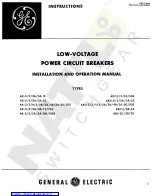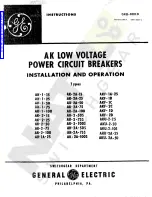
- 2 -
Table 1 Type of overcurrent release
Serial
number
Name
Description
1
Delay release With the overcurrent inverse time limit protection characteristic
2
Instantaneous
release
i.e. electromagnetic release, with the overcurrent instantaneous
operation protection characteristic
3
Complex
release
With the above two functions
Table 2 Internal accessory code
Inm
(A)
I
II
III
Notes
Code
Description
Code Description Code Description
63
100
250
0 N/A
0~2
Number of
auxiliary
contacts
0~2
Number of
alarm
contacts
1 Shunt trip
0~1
0~1
2 Undervoltage
release
0~1
0~1
400
0 N/A
0~5
0~2
I
I+III≤7
1 Shunt trip
0~3
0~2
I
I+III≤5
2 Undervoltage
release
0~3
0~2
II+III≤5
3 Shunt/Undervoltage
release
0~1
0~1
II+III≤2
630
800
0 N/A
0~8
0~3
II+III≤11
1 Shunt trip
0~6
0~3
II+III≤8
2 Undervoltage
release
0~6
0~3
II+III≤8
3 Shunt/Undervoltage
release
0~3
0~2
II+III≤5
4 Normal Working Conditions
The circuit breaker is suitable for the following working conditions:
4.1 The ambient air temperature shall not be higher than +40°C or lower
than -5°C.
4.2
Altitude ≤ 2,000 m.
4.3 The relative air humidity shall not exceed 50% at the maximum
temperature of +40°C. A higher relative humidity is allowed at a lower
temperature. The average minimum temperature of the wettest month
shall not 25°C, and the average maximum relative humidity of
that month shall not exceed 90%.
4.4 Contamination grade: Grade 3. There is no explosion danger and no
gas or conductive dust that corrodes metals or damages insulation in
the surrounding air.
4.5 The installation category is Grade III.
4.6 The "1, 3, 5 and N1" terminals of the circuit breaker are connected to
the power supply, and the "2, 4, 6 and N2" terminals are connected to
the load, which cannot be reversed.
4.7 The installation surface of the circuit breaker shall be vertical to the
horizontal plane. The circuit breaker is basically installed vertically, with
the power supply terminal at the top and the load terminal at the bottom,
and can also be installed horizontally.




























